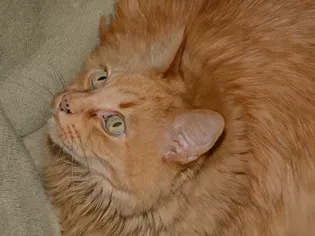What Are the Black Spots on My Orange Cat's Mouth & Nose?
Updated on 04/26/24

Unveiling the Enigma of Black Spots on Orange Cat's Mouth & Nose: A Comprehensive Guide
Adorned with vibrant orange coats, orange cats are a sight to behold. However, the appearance of enigmatic black spots on their mouths and noses can evoke a mix of curiosity and concern. To unravel the mystery behind these peculiar markings, let's embark on a comprehensive exploration of their causes and implications.
1. Lentigo Simplex: Benign Sun Spots
Similar to freckles on human skin, lentigo simplex manifests as flat, dark spots caused by an accumulation of melanin, the pigment responsible for skin color. These spots are typically found on sun-exposed areas, such as the face, mouth, and nose.
2. Solar Keratosis: Precancerous Lesions
While most black spots are benign, solar keratosis warrants attention. These lesions, often mistaken for lentigo simplex, are characterized by a rough, scaly texture and can progress to skin cancer if left untreated. Veterinary consultation is crucial for early detection and appropriate management.
3. Pigmented Nevus: Harmless Birthmarks
Pigmented nevi are non-cancerous skin growths caused by an overgrowth of melanocytes, the cells that produce melanin. They may vary in size, shape, and color, but typically pose no health concerns.
4. Post-inflammatory Hyperpigmentation: Healing Scars
When a cat experiences a skin injury, inflammation can trigger an increase in melanin production, resulting in dark spots as the wound heals. These spots are temporary and usually fade over time.
5. Porphyria: Metabolic Disorder
Porphyria is a rare inherited metabolic condition that affects the production of porphyrins, compounds essential for hemoglobin synthesis. In cats with porphyria, porphyrins can accumulate in the skin, leading to the development of black spots on the face, mouth, and nose.
6. Cutaneous Aspergillosis: Fungal Infection
This fungal infection, caused by Aspergillus species, can cause crusty, black lesions on the skin, including the mouth and nose. Veterinary diagnosis and treatment with antifungal medications are essential.
7. Melanoma: Skin Cancer
While rare in cats, melanoma is a potentially aggressive skin cancer that can appear as a rapidly growing, dark-pigmented mass. Early detection and surgical removal are crucial for successful treatment.
When to Seek Veterinary Attention
While most black spots on orange cats' mouths and noses are benign, it's important to consult a veterinarian if:
* The spots are new or rapidly changing in size or appearance
* The spots are accompanied by any other symptoms, such as itching, redness, or discharge
* The cat has a history of sun exposure or a weakened immune system
Diagnostic Tools
To determine the underlying cause of the black spots, your veterinarian may use various diagnostic tools, including:
* Physical examination
* Blood tests
* Skin biopsy
Treatment Options
The treatment for black spots on orange cats' mouths and noses depends on the underlying cause:
* Benign spots may require no treatment or simple monitoring
* Precancerous lesions may need surgical removal or cryotherapy (freezing)
* Birthmarks typically require no intervention
* Post-inflammatory hyperpigmentation resolves on its own over time
* Porphyria may require dietary changes or medications
* Fungal infections are treated with antifungal medications
* Skin cancer requires surgical removal and may necessitate additional therapies
Prevention and Care
While not all black spots can be prevented, there are measures you can take to reduce the risk of developing certain types:
* Limit sun exposure during peak hours
* Apply pet-safe sunscreen to exposed areas
* Feed a healthy diet to support immune function
* Regularly check your cat's skin for any changes
Conclusion
Black spots on orange cats' mouths and noses can be a common occurrence, ranging from harmless birthmarks to potentially serious conditions. By understanding the various causes and implications, you can provide your beloved feline companion with the best possible care. If you notice any unusual or concerning changes, do not hesitate to seek veterinary guidance. Remember, early detection and appropriate treatment can lead to optimal health outcomes for your furry friend.
Explore More Pets

Cat Behavior Problems
How to Stop Aggression in Kittens

Long-Haired Cat Breeds
Siberian Cat: Breed Profile, Characteristics, & Care

Cat Behavior Problems
How to Stop Kittens From Scratching and Biting

Long-Haired Cat Breeds
Turkish Angora: Cat Breed Profile, Characteristics & Care

Basic Training
How to Socialize Your Kitten

Short-Haired Cat Breeds
Cute Pictures & Facts About Calico Cats & Kittens

Litter Box Training
Training Your Kitten to Use the Litter Box

Long-Haired Cat Breeds
10 Fun Facts About White Cats